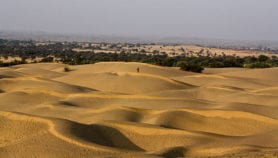By: Sophie Hebden
Send to a friend
The details you provide on this page will not be used to send unsolicited email, and will not be sold to a 3rd party. See privacy policy.
The world’s deserts will become less hospitable because of climate change and unsustainable human activities but could, if managed well, be sources of clean energy, new drugs and new crops.
These are among the findings of a report released today (5 June) by the UN Environment Programme (UNEP).
Population growth and inefficient water use could mean that countries such as Chad, Iraq, Niger and Syria face severe water shortages by 2050, it says.
Elsewhere, irrigation schemes have already caused salty groundwater to rise towards the surface and contaminate soils.
As a result, China’s Tarim river basin lost more than 12,000 square kilometres of farmland between 1960 and 1990. Parts of India and Pakistan have suffered similar fates.
The report says that climate change could raise temperatures by 5-7 degrees Celsius and reduce rainfall by 10-20 per cent in most deserts by the end of the century.
Despite these problems, the authors highlight new economic opportunities in desert areas including capturing solar energy, fish farming and researching desert plants as potential sources of new drugs and material to make drought and salt tolerant crops.
“If the huge solar-power potential of deserts can be economically harnessed the world has a future free from fossil fuels,” said Shafqat Kakakhel, UNEP’s deputy executive director.
To improve water management, the report recommends technological solutions such as efficient ‘drip’ irrigation and desalinating estuarine water rather than seawater as the process is faster and cheaper.More on Desert science
News
Climate change can dry south Indian river, says new study
[NEW DELHI] Climate change could lead to huge01/03/12
News
Agroforestry can fix Pakistan’s depleting tree cover
[ISLAMABAD] Using a mix of trees and crop species can help rejuvenate Pakistan's deteriorating ...16/12/11
News
Pakistan seeks tech fix for impending water crisis
[KARACHI] Pakistan is seeking technological solutions for an unfolding01/08/11
News
South Asia News in brief: 1–15 March 2008
Below is a round-up of news from or about South Asia for the period 1–15 March.20/03/08
News
Soil degradation issues ‘swept aside’, say experts
Soil scientists have called for more targeted research and strict guidelines to stop what they say is the m ...07/09/07
News
UN: Policymakers must rethink desertification
[BEIJING] A new policy report from the United Nations University (UNU) urges governments to adopt a more co ...28/06/07
News
Islamic fund created to secure food in Niger
A group of Islamic states have approved a five-year US$370 million fund to help combat desertification and ...19/06/07
News
Local people ‘vital to preventing desertification’
Integrating the livelihoods of local people into environmental management can help prevent the desertificat ...14/05/07





